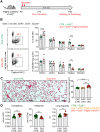This is a preprint.
Impaired Myofibroblast Proliferation is a Central Feature of Pathologic Post-Natal Alveolar Simplification
- PMID: 38187712
- PMCID: PMC10769348
- DOI: 10.1101/2023.12.21.572766
Impaired Myofibroblast Proliferation is a Central Feature of Pathologic Post-Natal Alveolar Simplification
Update in
-
Impaired myofibroblast proliferation is a central feature of pathologic post-natal alveolar simplification.Elife. 2024 Dec 11;13:RP94425. doi: 10.7554/eLife.94425. Elife. 2024. PMID: 39660606 Free PMC article.
Abstract
Premature infants with bronchopulmonary dysplasia (BPD) have impaired alveolar gas exchange due to alveolar simplification and dysmorphic pulmonary vasculature. Advances in clinical care have improved survival for infants with BPD, but the overall incidence of BPD remains unchanged because we lack specific therapies to prevent this disease. Recent work has suggested a role for increased transforming growth factor-beta (TGFβ) signaling and myofibroblast populations in BPD pathogenesis, but the functional significance of each remains unclear. Here, we utilize multiple murine models of alveolar simplification and comparative single-cell RNA sequencing to identify shared mechanisms that could contribute to BPD pathogenesis. Single-cell RNA sequencing reveals a profound loss of myofibroblasts in two models of BPD and identifies gene expression signatures of increased TGFβ signaling, cell cycle arrest, and impaired proliferation in myofibroblasts. Using pharmacologic and genetic approaches, we find no evidence that increased TGFβ signaling in the lung mesenchyme contributes to alveolar simplification. In contrast, this is likely a failed compensatory response, since none of our approaches to inhibit TGFb signaling protect mice from alveolar simplification due to hyperoxia while several make simplification worse. In contrast, we find that impaired myofibroblast proliferation is a central feature in several murine models of BPD, and we show that inhibiting myofibroblast proliferation is sufficient to cause pathologic alveolar simplification. Our results underscore the importance of impaired myofibroblast proliferation as a central feature of alveolar simplification and suggest that efforts to reverse this process could have therapeutic value in BPD.
Figures









Similar articles
-
Impaired myofibroblast proliferation is a central feature of pathologic post-natal alveolar simplification.Elife. 2024 Dec 11;13:RP94425. doi: 10.7554/eLife.94425. Elife. 2024. PMID: 39660606 Free PMC article.
-
Myofibroblast contraction is essential for generating and regenerating the gas-exchange surface.J Clin Invest. 2020 Jun 1;130(6):2859-2871. doi: 10.1172/JCI132189. J Clin Invest. 2020. PMID: 32338642 Free PMC article.
-
Phenotypic assessment of pulmonary hypertension using high-resolution echocardiography is feasible in neonatal mice with experimental bronchopulmonary dysplasia and pulmonary hypertension: a step toward preventing chronic obstructive pulmonary disease.Int J Chron Obstruct Pulmon Dis. 2016 Jul 14;11:1597-605. doi: 10.2147/COPD.S109510. eCollection 2016. Int J Chron Obstruct Pulmon Dis. 2016. PMID: 27478373 Free PMC article.
-
Signaling Pathways Involved in the Development of Bronchopulmonary Dysplasia and Pulmonary Hypertension.Children (Basel). 2020 Aug 18;7(8):100. doi: 10.3390/children7080100. Children (Basel). 2020. PMID: 32824651 Free PMC article. Review.
-
Understanding the Impact of Infection, Inflammation, and Their Persistence in the Pathogenesis of Bronchopulmonary Dysplasia.Front Med (Lausanne). 2015 Dec 21;2:90. doi: 10.3389/fmed.2015.00090. eCollection 2015. Front Med (Lausanne). 2015. PMID: 26734611 Free PMC article. Review.
References
Publication types
Grants and funding
LinkOut - more resources
Full Text Sources
